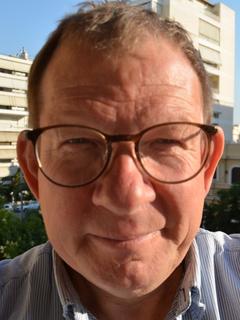
Date: Wed Jun 27, 2018
Time: 8:00 AM - 9:30 AM
Moderator: Dennis Buckmaster
The occurrence and number of herbicide-resistant weeds in the world has increased in recent years. Controlling these weeds becomes more difficult and raises production costs. Precision spraying technologies have been developed to overcome this challenge. However, these systems still have relatively high acquisition cost, requiring studies of the relation between the spatial distribution of weeds and the economically optimum spatial resolution of the control method. In this context, the objective of this work was to evaluate the best control resolution in simulated scenarios of weed distribution to create guidelines to relate the spatial variability of weed distribution with the optimum resolution of weed control. The methodology uses geostatistical simulations to construct different scenarios of weed distribution, based on real observations from Brazilian crop production fields. The simulations were made in a 0.1 X 0.1 m spatial resolution, considering only presence or absence of weeds to be sprayed in each pixel. We evaluated control resolution starting from 0.2 X 0.2 m to 36 X 3 m, considering section widths and valves on/off timing. In each scenario we calculated the minimum area to be sprayed using each technology, targeting a minimum of 99% of weed control. The economical evaluation was based on the total application cost, considering the herbicide savings and the increase in application cost of each technology. Low incidence levels and random distribution of weeds is favorable for sub meter control resolutions. For section control based applications the range is the more important parameter for predicting herbicide savings, and for nozzle control the nugget effect is more important. The raise in herbicide control costs are likely to be a key driver in the adoption of precision spraying technologies.

Electrostatic application of spray drops provides unique opportunities to precisely control the application of pesticides due to the additional electrostatic force on the spray drops, in addition to the normally seen forces of aerodynamic drag, gravity, and inertia. In this work, we develop a computational model to predict the spray drop trajectories. The model is validated through experiments with high speed photography of spray drop trajectories, and quantification of which trajectories lead to the "wrap-around effect", which results in drop deposition on the back side of the target leaf or fruit surface.
Driven by 25 years of Danish, political 'pesticide action plans', aiming at reducing the use of pesticides, a Danish Decision Support System (DSS) for Integrated Weed Management (IWM) has been constructed. This online tool, called ‘IPMwise’ is now in its 4th generation. It integrates the 8 general IPM-principles as defined by the EU.
In Denmark, this DSS includes 30 crops, 105 weeds and full assortments of herbicides. Due to generic qualities in both the integrated agro-biological models and in the IT setup, this DSS concept is currently being customized and validated for release also in Norway, Germany and Spain.
In these countries, results from field validation experiments with this DSS show that recommendations are sufficiently, agronomically robust, and has a yet unexploited potential for reducing the use of herbicides of 20-40%, as compared to references.
These potentials arise from exploitation, mainly of the following conditions: 1) weeds are unevenly distributed in time and space, 2) a complete weed kill is never required, 3) some weed species can be controlled sufficiently by down to 10% of a registered herbicide dose rate. In addition, the DSS can optimize the composition of 2–4-way tank-mixtures and thereby offer recommendations for a wide range of weed infestations.
The lack of implementation and exploitation has been thoroughly investigated in sociological studies, where farmer’s reluctance against manual weed scouting was identified as a dominating obstacle.
In a Danish project with the acronym name 'RoboWeedMaPS' (2017-20), these challenges are addressed by use of manual/automatic analyses of weed infestations, as detected from pictures and structured as required by ‘IPMwise’.
Automated weed image acquisition and semi-automated weed annotation was used to feed ‘IPMwise’, where herbicide recommendations on herbicide application were achieved on three levels i.e. field level, on/off application in points, and full precision variable dose. The results demonstrated the potential savings of the three strategies compared to the farmers actual herbicide application, which in a closer examination by ‘IPMwise’ turned out to have unsatisfactory low efficacy on some important weeds. The result was transferred to an herbicide application map and the spatial variability was analyzed and evaluated. This showed a potential of 61% reduction of herbicide cost by changing decision making from the field level to a 10 x 10 m grid.

As one of the most common mulberry pests, Diaphania pyloalis Walker (Lepidoptera: Pyralididae) has occurred and damaged in the main sericulture areas of China. Naked eye observation, the most dominating method identifying the damage of Diaphania pyloalis, is time-wasting and labor consuming. In order to improve the identification and diagnosis efficiency and avoid the massive outbreak of Diaphania pyloalis, near infrared (NIR) hyperspectral imaging technology combined with partial least discriminant analysis (PLS-DA) and Successive projections algorithm (SPA) algorithm was applied to establish a fast and nondestructive detection method of Diaphania pyloalis larva. Hyperspectral images of samples were collected and corresponding spectra data was extracted, then classification models were established.
Results showed that the mean value of the correct rate of calibration and prediction (M_CR) of PLS-DA model with full variables was 76.65%, nevertheless, the absolute difference between the correct rate of calibration and prediction (AB_CR) value was 31.55%. After variable selection calculation, the AB_CR value was reduced to 2.77% based on SPA-PLS-DA model with 9 selected variables, it showed that the robustness of model was improved. In conclusion, hyperspectral imaging coupled with chemometrics method showed a certain potential in the rapid detection of Diaphania pyloalis larvae on mulberry leaves.
Spray drift is defined as physical movement of pesticides by air action as a particle droplet and is not deposited on the intended target. Evaluation of the parameters affecting on spray drift is difficult. The accurate studies are expensive, as well as, the variability is high under field conditions due to instability in wind speed and turbulence. Wind tunnel experiments are adequate to simulate the results of field measurements for spray drift. A laboratory experiments were carried out to study the variability in the wind tunnel for measuring sedimentation of spray drift under stable weather conditions, and boom height. Different models are conducted in this study using three type of nozzles of Flat fan nozzle, Flat fan air injection(single jet) and flat fan air injection (twin jet). All these nozzles at the same angle and size 110 02, three wind speeds of 2, 4, and 7.5 ms-1, and the boom height was of 60 cm. Distribution test bench used for measuring sedimentation of spray drift . Air temperature and relative humidity were 20º and upon 95% respectively. Main results showed low variability in the measuring of sedimentation of spray drift in a wind tunnel experiments compared to the previous studies. Higher variability observed with flat fan air induction nozzle twin jet compared to other nozzles tested in this study.
Basal stem rot (BSR), caused by Ganoderma boninense is known as the most damaging disease in oil palm plantations in Southeast Asia. Ganoderma could reduce the productivity of oil palm plantations and potentially reduce the market value of palm oil in Malaysia. Early disease management of Ganoderma could prevent production losses and reduce the cost of plantation management. This study focuses on identifying the thermal properties of healthy and BSR-infected tree using a thermal imaging technique. Thermal images of canopy section of oil palm trees from healthy and BSR-infected trees were captured. The images were processed to extract pixel value representing thermal properties of the trees. These values were statistically analysed. Selected principal component scores were used in classification k-nearest neighbour (kNN) and Support Vector Machine (SVM) multivariate classification algorithms. The algorithms were tested to classify the thermal images into healthy and BSR-infected group. The results demonstrated that when average pixel value of trees were used, the SVM-based model resulted in the highest average overall classification accuracy of 89.2% for training set and 84.4% for test set. This verifies the potential of thermal imaging for BSR detection in oil palm trees.
